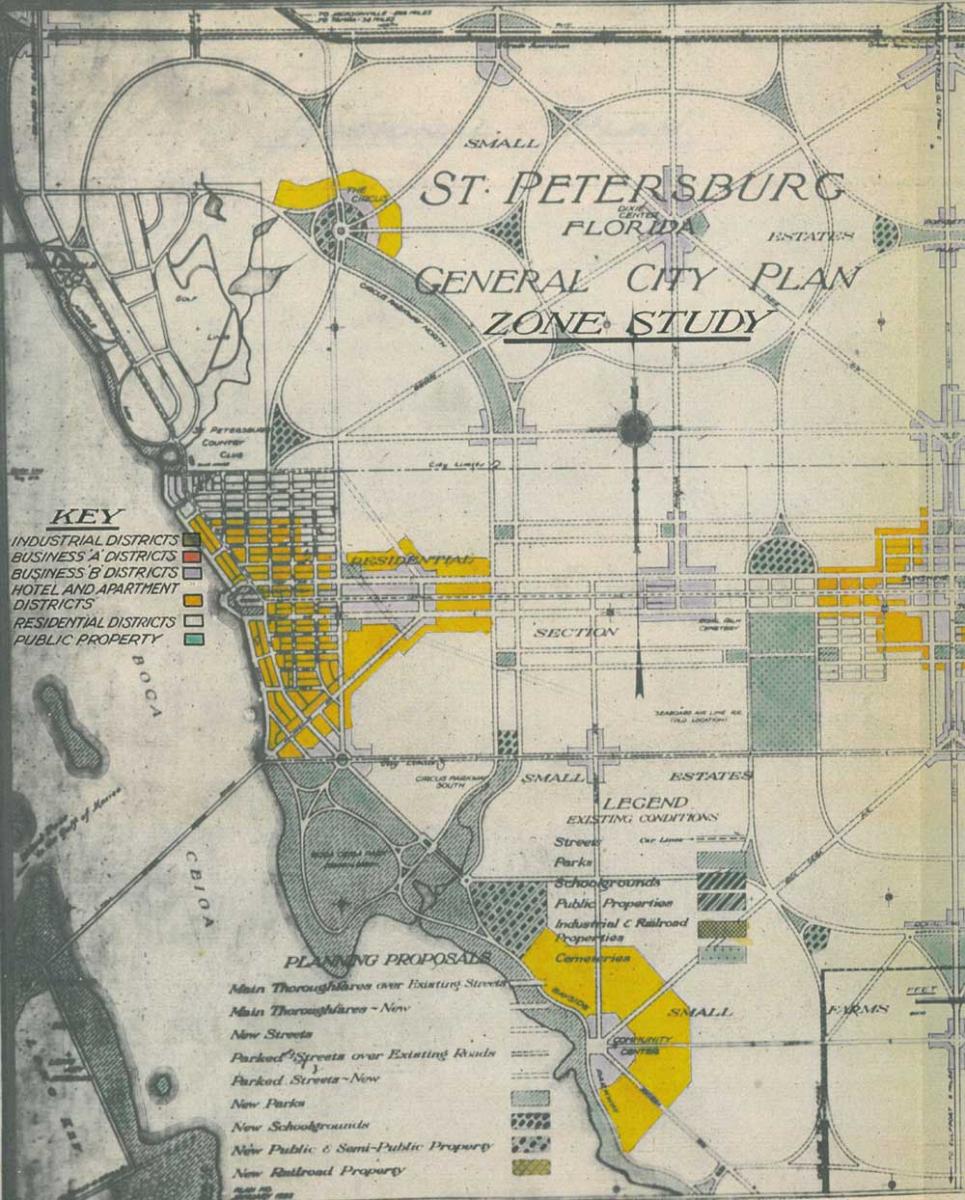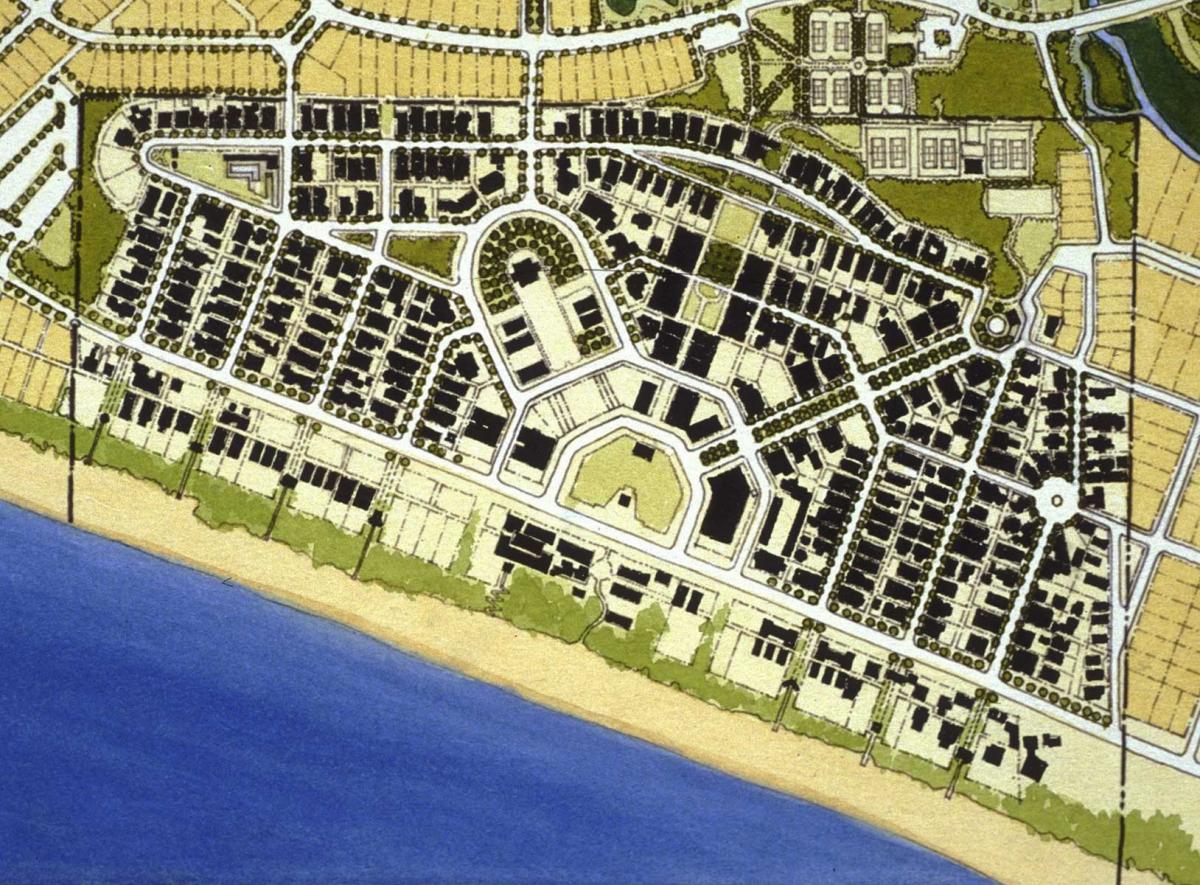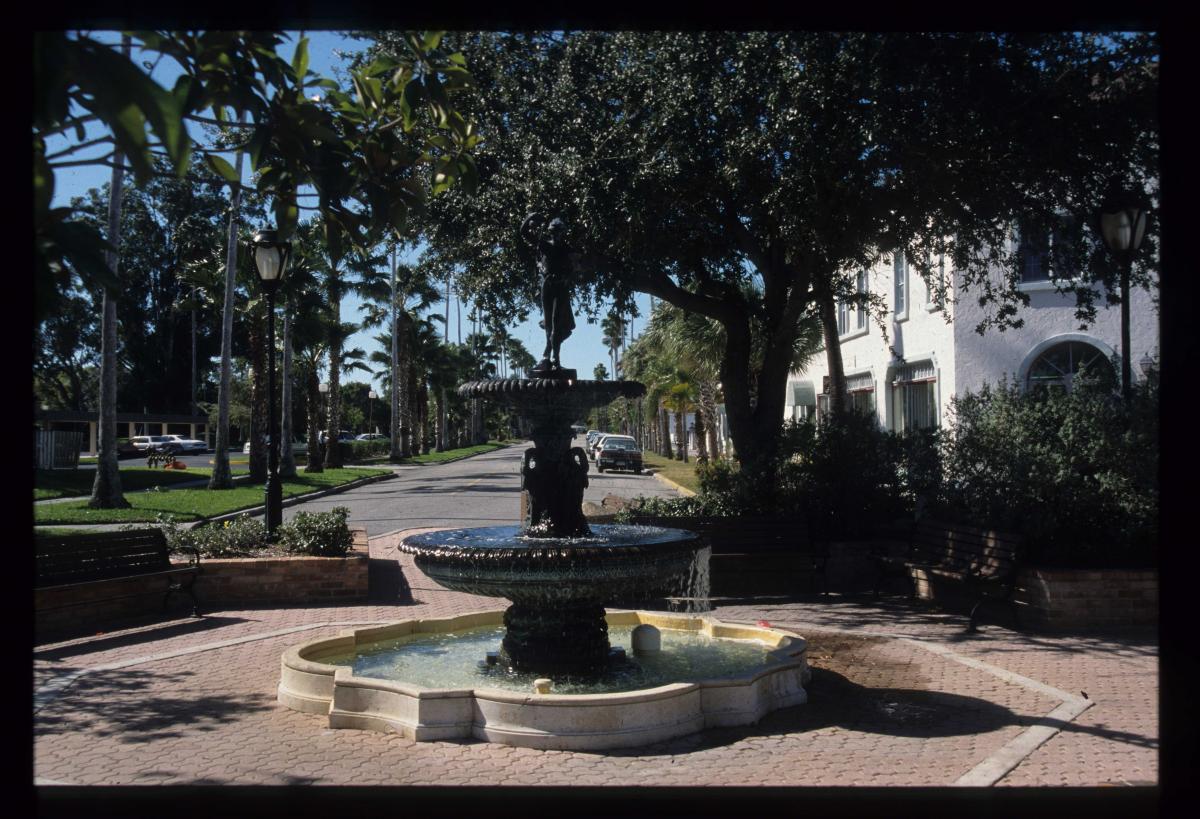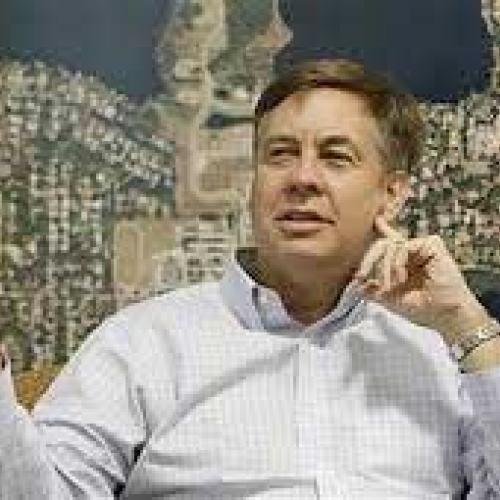
The enduring legacy of John Nolen
Providing St. Petersburg, Florida, with good city planning was John Nolen’s intent when he drafted Florida’s first comprehensive city plan, a vision of an American Riviera with interconnected systems of parks and preserves giving public access to beaches and bays. To prevent “an unhappy situation on the shoreline through the excessive and illogical building out into the water,” Nolen instructed municipal officials to establish a bulkhead line limiting fills to areas contiguous with the coastline.
The recommendation went unheeded. In 1940 Harland Bartholomew, hired to update St. Petersburg’s city plan, dismissed Nolen’s work as the “optimistic opinion of the ideal city.” His new plan was drawn on the premise that cities were like machines and should be engineered to run efficiently. The natural conditions that Nolen deemed essential were ignored.

By 1970, 25 percent of the Boca Ciega Bay had been either dredged or filled. It took a federal legal precedent, Zabil V. Tabb, to end the “monstrous desecration,” as Florida Gov. Leroy Collins called it, of the coastal lagoon. Forty years after Nolen recommended the policy, bulkhead lines were established to rein in dredging. In 1973 the St. Petersburg City Planning Department prepared one of the nation’s first growth management plans using Ian McHarg’s ecological design method. No one knew that the new plan paralleled Nolen’s 1923 work because the only copy of Florida’s first regional plan was boxed in the Cornell University archives. Although new plans were implemented, the problems in St. Petersburg were too severe to reverse.
Today St. Petersburg’s bays are fouled, its pedestrian death rate is the nation’s second highest, and a hurricane will wreak havoc on the heavily populated barrier islands. Yet St. Petersburg is not without hope. In the early 2000s, Nolen’s plan informed a wide-ranging civic initiative to create a more pedestrian-oriented and ecologically balanced city. Difficulties remain, but St. Petersburg is experiencing a rebirth. Billing itself as Florida’s “first green city,” it is struggling to take form along the lines Nolen envisioned.
In the mid-1980s, Miami architects Andres Duany and Elizabeth Plater-Zyberk and their firm DPZ also rediscovered Nolen’s work. The inspiration for their plan of Seaside, Florida, the prototype new urbanist community, came from Nolen’s new towns, especially Venice, Florida. As James Howard Kunstler observed in 1993, “Seaside is a modified neoclassical grid straight out of John Nolen.” By then Seaside was the most studied new town project in the nation. Before Duany and his firm uncovered the value of Nolen’s work, the urban planner was “frequently viewed as the PT Barnum of early 20th Century planning, a man who used his considerable public relations and networking skills to popularize the idea of city planning,” according to author William Fulton. By contrast, Duany saw Nolen as a skilled designer who was the equal of his more acclaimed contemporaries—the Olmsted Brothers, Clarence Stein, and Henry Wright. Nolen’s ability to create walkable towns with a sophisticated mix of parks, housing types, streets, and shops appealed to Duany, who also realized that environmental protection and human-scaled town planning were inseparable. By 1989 he was calling on planners to combat the spread of “placeless” suburbs by practicing the art mastered by Nolen.

In 1990 the University of Miami School of Architecture, where Plater-Zyberk was a professor, hosted a symposium on Nolen, and the university art museum displayed his plans. The event documented the relevance of John Nolen’s work to current practice, as well as to the cities he had planned. DPZ established an office in Myers Park, a neighborhood designed by Nolen in Charlotte, North Carolina. Tom Low, one of the nation’s leading experts on Nolen, headed the office. The firm also allied itself with West Coast architects Peter Calthorpe, Dan Solomon, Liz Moule, and Stafanos Polyzoides to form a coalition dedicated to building walkable neighborhoods based on historical precedent. In 1993 the six architects founded the Congress for the New Urbanism, which published a Charter demanding “the restoration of existing urban centers and towns within coherent metropolitan regions, the reconfiguration of sprawling suburbs into communities of real neighborhoods and diverse districts, the conservation of natural environments, and the preservation of our built legacy.” In 1919 Nolen had made a similar pronouncement, calling on the federal government to build systems of interconnected villages, towns, and cities that would unite regions, preserve natural systems, and support industrial democracy.”
The New Urbanism inspired intense debate, especially among academicians. Critics claimed the “neotraditional” towns and neighborhoods, like Nolen’s Union Park Gardens in Wilmington, Delaware, marked a fine line between meeting market demand and pandering to sentimental visions of a mythic community, according to author John Dutton. But this debate over style did not deter the movement’s central message—the need to build sustainable, pedestrian-oriented communities. New Urbanism quickly moved from novelty to policy, inspiring reforms in public housing, coastal zone planning, environmental protection, transportation policies, and municipal coding, according to authors and academics Ellen Dunham-Jones and June Williamson. Duany realized that there were few precedents for implementing the new plans, in part because Nolen “could count on the competence of architects to behave in an urbanistically responsible way.” Moreover, as Nolen pointed out, zoning codes remained “a negative measure” that “simply tells what private property owners cannot do with their property.” DPZ developed a new tool to guide plan implementation: the “form-based code.” Rather than regulating floor area ratios and separating uses, the form-based code addressed the mass, scale, and design of the built environment. With a more detailed physical configuration of a property and its buildings, developers could visualize how a project might accrue value over time.

Civic-minded developers in the mold of George Stephens and Charles Livingood also brought Nolen’s legacy to fruition. In 1995 developer D.R. Bryan studied Myers Park and historical neighborhoods in Winston-Salem before drafting a plan for Southern Village, a Chapel Hill suburb. Over half of the 1,175 housing units, including townhouses on John Nolen Lane, were clustered at 10 units per acre and set within an interconnected park system. A school and mixed-use town center were focal points of the plan. Getting the project built required convincing officials to reconfigure Chapel Hill’s existing codes, which facilitated automobile traffic rather than pedestrian movement. Southern Village’s profitable mix of residences, parks, and retail drew national attention, with feature articles in Time, The Wall Street Journal, Builder, and US News & World Report. Studies found that residents drive less and walked more. Southern Village also performed significantly better than conventional subdivisions in safeguarding water quality and mitigating the impact of storm water runoff.
After the collapse of he real estate market and the onset of the Great Recession in 2008, Venice became an important test case. The city had weathered Florida’s economic maelstrom reasonably well, especially when compared to other sprawling developments in the region. For example, in 2010 Venice had 60 percent fewer foreclosures than nearby Leigh Acres, and its average sale price of $110 per square foot was three times higher. But economics was only one measure of stability. Spencer Briggs, a filmmaker who directed a PBS documentary on Nolen’s enduring influence on Venice, found that the town’s compact form made it not only charming but also “democratic because it’s walkable.” A memorial had been built to honor Nolen in 1976, and citizens of Venice still discuss his “intentions with the passion of constitutional scholars seeking the thinking of the Founding Fathers.”
In Madison, Nolen’s ideal of a model city became a local legacy. In 1995 a symposium called “Nolen in the ‘90s” drew three hundred participants who debated how to engage in his visionary planning. Three more such events were held in the next decade. Inspired by Madison: A Model City, experts and citizens collaborated to produce an agenda that moved Madison to the vanguard of the urban sustainability movement. In 2011 a local journalist proposed repurposing Nolen’s plan “for the next century,” writing that it is still capable of setting a “new standard for city-making.”
Nolen’s accomplishments are also acknowledged by the planning, architecture, and environmental professions as well as by civic organizations throughout the country. In 1998 the American Planning Association honored Nolen as a national planning pioneer, and a decade later it designated Mariemont, Ohio, one of the “Great Places in America.” The Florida chapter of the Congress for the New Urbanism awards the John Nolen Medal, while the San Diego chapter of the American Institute of Architects and the University of Wisconsin Arboretum confer the John Nolen Award. The arboretum, the nation’s longest ongoing ecological restoration project, represents Nolen and Leopold’s effort to counter the destructive use of land, a central tenant of the sustainability movement. Nolen’s designs also became a source of guidance and inspiration for civic groups in Charlotte, Savannah, Madison, and Venice. The current city plans for Roanoke, Clearwater, and Sarasota are prefaced by Nolen’s plans.

With the rise of the New Urbanism and smart growth movements, Nolen’s concept of planning has taken hold and is continuing to evolve. Infill projects, form-based codes, livability indicators, transit-oriented development, and ecological restoration are now integral to the planning profession. Nolen would undoubtedly recognize the scale and intent of these initiatives and identify with the challenges facing new urbanist planners. Confronting the modernist agenda in 1930, Nolen feared “the merging of neighborhoods into a soulless urban mess.” His solution was to strike a balance between nature and the city, as well as equilibrium between public and private rights. “If this could be realized,” he wrote, “it would seem to be Utopia enough in this modern commercial world of ours.” With Nolen’s body of work as a historical precedent, today’s practitioners have an invaluable aid in their struggle to achieve “Utopia enough.”
This article was excerpted from Bruce Stephenson’s book, John Nolen: Landscape Architect and City Planner, published by the University of Massachusetts Press.




